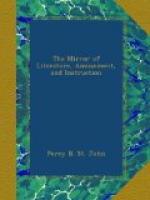their maturity depending upon the temperature of the
season, their quantity of food, &c. They are
at least six weeks or two months after they have spawned
before they recover their flesh; and the time when
these fish are at the worst, is likewise the worst
time for fly-fishing, both on account of the cold
weather, and because there are fewer flies on the
water than at any other season. Even in December
and January there are a few small gnats or water-flies
on the water in the middle of the day, in bright days,
or when there is sunshine. These are generally
black, and they escape the influence of the frost by
the effects of light on their black bodies, and probably
by the extreme rapidity of the motions of their fluids,
and generally of their organs. They are found
only at the surface of the water, where the temperature
must be above the freezing point. In February
a few double-winged water-flies, which swim down the
stream, are usually found in the middle of the day,
such as the willow-fly; and the cow-dung-fly is sometimes
carried on the water by winds. In March there
are several flies found on most rivers. The grannam,
or green-tail-fly, with a wing like a moth, comes
on generally morning and evening, from five till eight
o’clock, A.M. in mild weather, in the end of
March and through April. Then there are the blue
and the brown, both ephemerae, which come on, the first
in dark days, the second in bright days; these flies,
when well imitated, are very destructive to fish.
The first is a small fly, with a palish yellow body,
and slender, beautiful wings, which rest on the back
as it floats down the water. The second, called
the cob in Wales, is three or four times as large,
and has brown wings, which likewise protrude from
the back, and its wings are shaded like those of a
partridge, brown and yellow brown. These three
kinds of flies lay their eggs in the water, which
produce larvae that remain in the state of worms, feeding
and breathing in the water till they are prepared
for their metamorphosis, and quit the bottoms of the
rivers, and the mud and stones, for the surface, and
light and air. The brown fly usually disappears
before the end of April, likewise the grannam; but
of the blue dun there is a succession of different
tints, or species, or varieties, which appear in the
middle of the day all the summer and autumn long.
These are the principal flies on the Wandle—the
best and clearest stream near London. In early
spring these flies have dark olive bodies; in the end
of April and the beginning of May they are found yellow;
and in the summer they become cinnamon coloured; and
again, as the winter approaches, gain a darker hue.
I do not, however, mean to say that they are the same
flies, but more probably successive generations of
ephemerae of the same species. The excess of
heat seems equally unfavourable, as the excess of
cold, to the existence of the smaller species of water-insects,
which, during the intensity of sunshine, seldom appear




